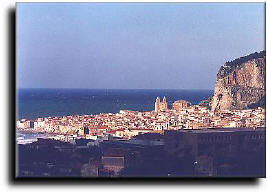|
Cefal¨
is 148 km. far from Agrigento, 130 km. from Caltanissetta, 183 km. from
Enna, 185 km. from Messina, 74 km. from Palermo, which province it belongs
to, 256 km. from Ragusa, 241 km. from Siracusa, 173 km. from Trapani. The municipality has 13.997 inhabitants and its area covers 6.580 hectares for a density of population of 213 inhabitants per square kilometre. It rises on a coast hilly area and is 16 metres above sea-level. Cefal¨ is a typical bathing small town and an agricultural centre and as such it has some products like olives, grapes, fruit and citrus fruit. Important are also its fish products whether fresh fish or canned-fish.
Famous tourist centre in the ancient times it was called Kephaloidion that
originates from the Greek word kefalŔ (head), referring to the rock that
overlooks it. The place is on the west slopes of a spendid promontory.
Cefal¨ has got many important monuments. The valuable Cathedral erected in 1131, inside is full of works of art among them there are precious mosaics; Piraino Palace of Cinquecento; the church of St. Maria della Catena ornated by a pretty portico; the church of Purgatory and the Monte PietÓ (Mount Piety) dated back to the Baroque period. Further there is the pre-historic Sanctuary called Tempio di Diana (Temple of Diana) that dates back to the V century B.C.. It is placed on a cliff that overlooks the centre and near it is placed the Sanctuary of Gibilmanna, built in the XVI century is destination of pilgrimages from all Sicily. Very important and particularly interesting as monument is the solemn and vivid figure of the Cristo Pantocratore which dominates the high part of the apse's area of the Cathedral. The attention is suddenly caught by the magnificent image of Christus with the right hand that blesses and the left hand holds the Holy Scriptures. |

